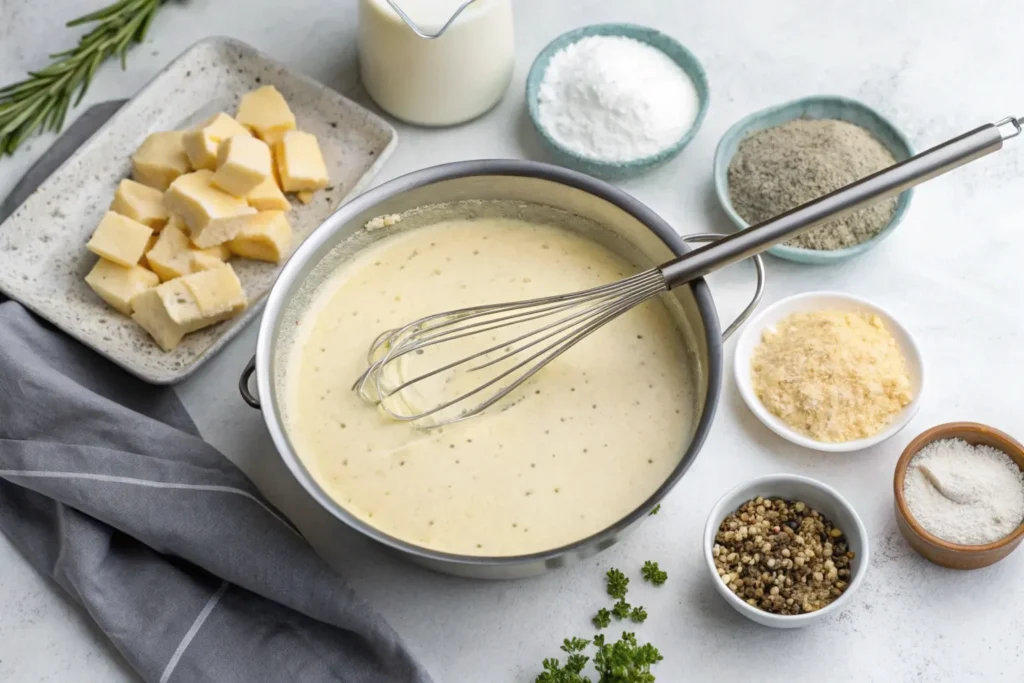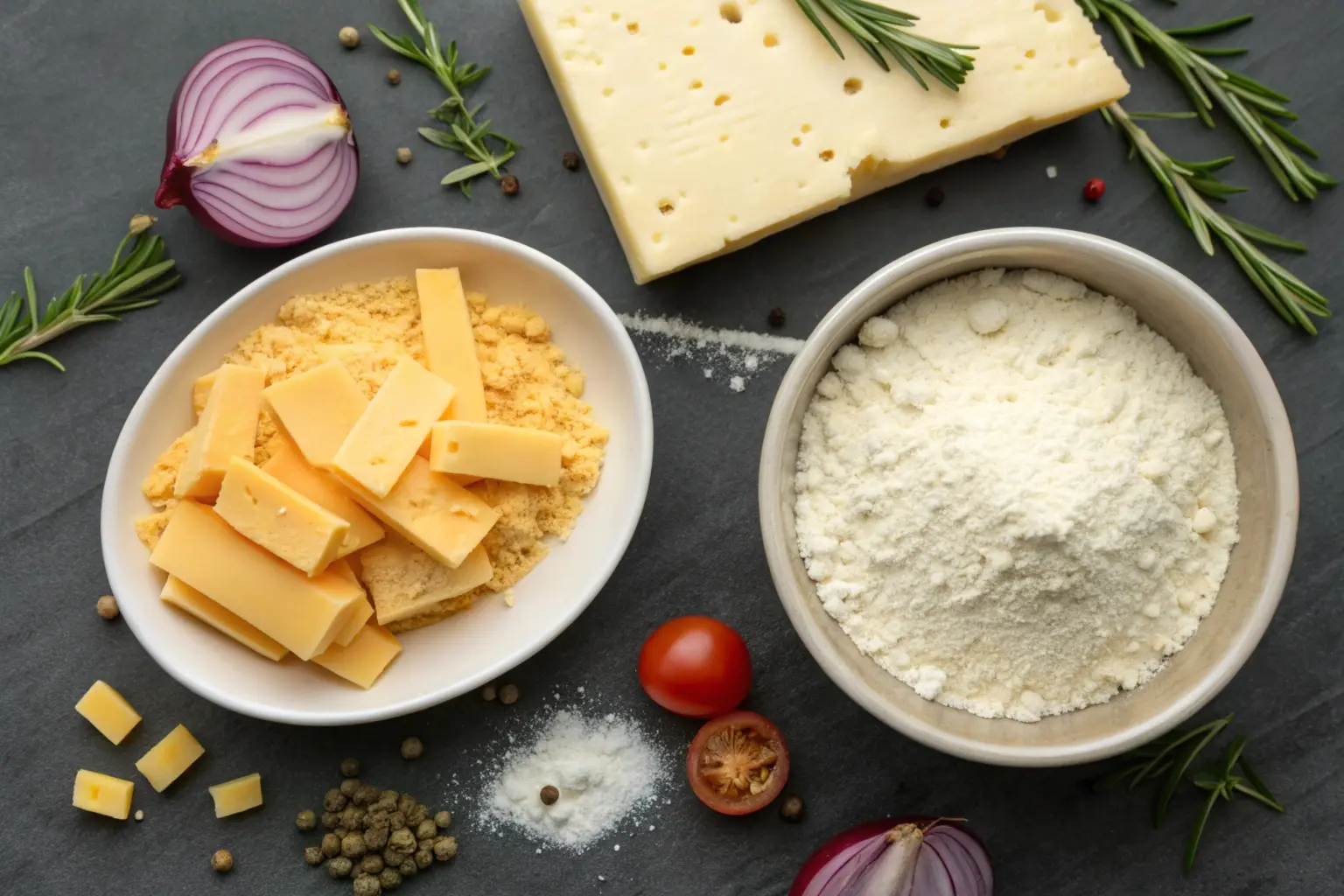Cheese is a beloved ingredient, bringing richness and flavor to countless dishes. But what if you’re out of fresh cheese or need a long-lasting alternative? That’s where powdered cheese comes in! You might wonder, “Can I use dehydrated cheese instead of fresh cheese?” The answer is yes—but with a few considerations. This article dives deep into what cheese powder substitutes are, how they compare to traditional cheese, and how to use them in your favorite recipes. Let’s explore this versatile ingredient and its many possibilities.
What Is Cheese Powder?
How Cheese Powder Is Made
Powdered cheese is a pantry-friendly alternative to traditional cheese, offering both flavor and convenience. But how is it made? The process starts with fresh cheese, which is melted down and mixed with stabilizers like whey or non-fat dry milk. This mixture is then spray-dried into a fine powder, locking in the cheesy flavor while extending its shelf life.
The result is a lightweight, shelf-stable product that retains the essence of cheese. Unlike fresh cheese, which can spoil quickly, dehydrated cheese can last for months when stored properly. This makes it a versatile ingredient for home cooks who want to enjoy cheesy flavors without the hassle of refrigeration or frequent shopping trips.
Cheese powder alternatives are not just byproducts—they’re designed to deliver consistent flavor and texture, making them perfect for a wide range of recipes. So, if you’re wondering, “Can I use powdered cheese instead of cheese?” understanding how it’s made can help you see its value in your kitchen.
Types of Powdered Cheese Available
Powdered cheese comes in various flavors and types, each suited for different culinary purposes. The most common types include:
- Cheddar Powder: Known for its bold, tangy flavor, this is the go-to option for mac and cheese, cheesy dips, and popcorn seasoning.
- Parmesan Powder: A sharper, nuttier option that’s perfect for pasta, soups, or as a topping for roasted vegetables.
- Mozzarella Powder: While less common, this variety works well for pizza-inspired dishes or sauces requiring a mild, creamy base.
- Specialty Blends: Some dehydrated cheese products are pre-mixed with seasonings like garlic, paprika, or herbs, offering a unique flavor profile that can elevate any recipe.
Each type of cheese powder has its own characteristics, making it important to choose the right one based on your recipe. For example, cheddar cheese powder is ideal for adding a bold, cheesy kick, while Parmesan powder brings a more subtle, savory touch.
Why Use Powdered Cheese?
The question “Can I use powdered cheese instead of fresh cheese?” often arises because of its unique benefits. Dehydrated cheese is lightweight, easy to store, and incredibly versatile. It dissolves smoothly in liquids, making it ideal for sauces, soups, and dips. Moreover, it blends effortlessly into dry mixes for baked goods, seasonings, or snacks.
Unlike fresh cheese, which can be tricky to melt evenly, cheese powder alternatives deliver consistent results every time. Whether you’re whipping up a quick pasta dish or experimenting with gourmet popcorn toppings, powdered cheese provides a hassle-free way to enjoy the rich flavor of cheese without the mess or perishability.
By understanding how dehydrated cheese is made and the types available, you can confidently explore its potential in your cooking. In the next section, we’ll compare powdered cheese to traditional cheese to help you decide when it’s the best substitute for your favorite recipes. Stay tuned!
Comparing Cheese Powder and Traditional Cheese
Flavor Profiles and Texture Differences
Can I use cheese powder instead of cheese? The answer depends on the flavor and texture you’re looking for in your dish. Cheese powder offers a concentrated, cheesy flavor that’s consistent and evenly distributed. However, it lacks the creamy, gooey texture that fresh cheese provides when melted. For instance:
- Cheese Powder: Best for adding cheesy flavor to sauces, soups, and dry mixes. It’s smooth when blended but won’t stretch or melt like traditional cheese.
- Traditional Cheese: Offers a rich texture, with varying melting properties based on the type of cheese. Perfect for pizzas, grilled cheese, or casseroles where stretchiness matters.
While cheese powder excels in convenience and flavor consistency, it’s not a perfect substitute for recipes requiring the distinctive texture of melted cheese.
Nutritional Value Comparison
Nutritionally, cheese powder differs from fresh cheese in a few key ways. During the dehydration process, some natural fats and proteins may be reduced, while additives like whey and preservatives are included for stability. Here’s a general comparison:
- Cheese Powder: Typically lower in fat and calories per serving, but it may contain added sodium or artificial flavors.
- Traditional Cheese: A natural source of calcium and protein, but higher in saturated fats and calories.
If you’re looking to reduce fat content while still enjoying a cheesy flavor, cheese powder can be a practical option. However, those seeking whole, unprocessed ingredients might prefer fresh cheese.
Benefits of Using Powdered Cheese
Convenience and Shelf Life
One of the biggest advantages of cheese powder is its convenience. Unlike fresh cheese, which requires refrigeration and has a shorter shelf life, cheese powder can be stored in your pantry for months. It’s ready to use whenever you need it, making it a reliable ingredient for quick recipes or emergencies.
Additionally, cheese powder is lightweight and easy to measure. Whether you need a pinch to season popcorn or a few tablespoons for a cheese sauce, it eliminates the hassle of shredding or melting cheese. Its long shelf life also means you can buy in bulk without worrying about spoilage.
Versatility in Recipes
Cheese powder’s versatility is another reason it’s a great substitute in many dishes. It blends seamlessly into both dry and liquid recipes, providing a consistent cheesy flavor. Some popular uses include:
- Cheese Sauces: Whisked into milk or cream, cheese powder creates a smooth, flavorful sauce for pasta or vegetables.
- Seasonings: Perfect for sprinkling on popcorn, chips, or roasted nuts for a cheesy kick.
- Baking: Added to bread or biscuit dough, it gives a subtle cheesy flavor without affecting texture.
With so many possibilities, it’s easy to see why cheese powder has become a kitchen staple. In the next section, we’ll explore how to substitute cheese powder for traditional cheese in your favorite recipes while maintaining balance and flavor. Stay tuned!
Best Ways to Substitute Powdered Cheese for Fresh Cheese
How to Use Powdered Cheese in Cooking

When substituting powdered cheese for traditional cheese, knowing how to incorporate it correctly ensures your dishes turn out delicious. Here’s a simple guide:
- For Sauces and Soups: Dissolve dehydrated cheese in a warm liquid like milk, cream, or water. Whisk it in gradually to prevent clumping and create a smooth, creamy consistency.
- For Baking: Add cheese powder alternatives directly to doughs or batters. Its dry texture integrates well and doesn’t disrupt the moisture balance.
- For Seasonings: Sprinkle powdered cheese over snacks like popcorn, fries, or roasted vegetables for an instant cheesy upgrade.
Cheese powder’s versatility allows you to enhance a wide variety of dishes without the need for grating, shredding, or melting fresh cheese.
Adjusting Ratios and Balancing Flavors
Since powdered cheese is more concentrated than fresh cheese, you’ll need to adjust the amounts to avoid overpowering your dish. Start with a smaller quantity and taste as you go. A good rule of thumb is to use 1 tablespoon of dehydrated cheese for every ounce of fresh cheese called for in a recipe.
For richer flavors, pair cheese powder alternatives with complementary ingredients like garlic, herbs, or a splash of cream. This ensures your dishes remain flavorful without being overly salty or one-dimensional.
Popular Recipes Using Cheese Powder as a Substitute
Cheesy Sauces and Soups
Can I use powdered cheese instead of fresh cheese? Absolutely, and soups and sauces are the perfect place to start! Here are some ideas:
- Mac and Cheese Sauce: Replace shredded cheese with a mix of dehydrated cheese and milk for a creamy, velvety sauce.
- Cheese Soup: Stir powdered cheese into broth or cream-based soups to create a rich, cheesy flavor. It works wonders in broccoli cheddar soup or potato soup.
Snacks and Seasonings

Powdered cheese is a game-changer for quick snacks and dry seasonings. Try these options:
- Popcorn Seasoning: Toss popcorn with melted butter and cheese powder substitutes for a savory, addictive treat.
- Cheesy Chips: Sprinkle dehydrated cheese over freshly baked or fried chips for a restaurant-quality snack.
- Spice Blends: Mix powdered cheese with paprika, garlic powder, and cayenne to create a versatile seasoning for fries, vegetables, or even chicken.
By experimenting with these recipes, you’ll discover how easily cheese powder alternatives can replace fresh cheese without compromising flavor.
FAQs About Substituting Powdered Cheese for Fresh Cheese
Can Powdered Cheese Replace Fresh Cheese in All Recipes?
Can I use powdered cheese instead of fresh cheese? Yes, but not in every scenario. Dehydrated cheese works best in recipes where its dry, concentrated form can blend seamlessly, such as sauces, soups, and seasonings. However, it’s less suitable for dishes that rely on the gooey texture of melted cheese, like pizza or grilled cheese sandwiches.
If your recipe calls for a stretchy, melted effect—think lasagna or fondue—fresh cheese is irreplaceable. On the other hand, powdered cheese alternatives shine when you need bold, cheesy flavor without altering the moisture content of the dish.
Does Powdered Cheese Melt Like Regular Cheese?
Dehydrated cheese doesn’t melt the way fresh cheese does. Instead of becoming gooey and stretchy, it dissolves into a smooth, creamy consistency when mixed with liquids. This makes it ideal for dishes like mac and cheese, soups, or cheesy dips where flavor is the focus rather than texture.
For recipes requiring a melty consistency, try combining cheese powder substitutes with ingredients like cream or butter to create a rich, creamy sauce. While it won’t replicate the exact melt of fresh cheese, it’s a great alternative for many recipes.
What Is the Shelf Life of Dehydrated Cheese?
One of the biggest advantages of powdered cheese is its long shelf life. Unlike fresh cheese, which needs refrigeration and spoils within weeks, cheese powder alternatives can last for months or even years if stored properly. Here are some storage tips:
- Airtight Containers: Store dehydrated cheese in a sealed container to protect it from moisture and air exposure.
- Cool, Dry Place: Keep it in a pantry or cupboard away from direct sunlight and humidity.
- Check the Expiry Date: While powdered cheese is long-lasting, it’s still important to use it before the expiration date for the best flavor and quality.
By understanding how and when to use powdered cheese, you can confidently answer the question, “Can I use dehydrated cheese instead of fresh cheese?” Its convenience and versatility make it a valuable addition to any kitchen, whether you’re cooking daily meals or experimenting with creative recipes.ther you’re cooking daily meals or experimenting with new recipes.

